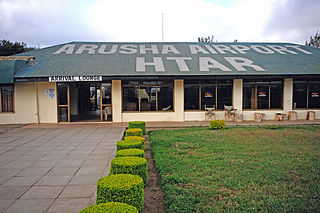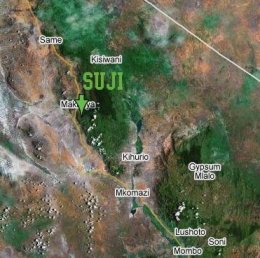
Arusha City is a Tanzanian city, with a population of 617,631, and the regional capital of the Arusha Region, with a population of 2,356,255.

Tanga is a historic city and the capital of Tanga Region. The city is the most northernly port city of Tanzania to the west of the Indian Ocean on Tanga Bay. The city has a population of 393,429 in 2022. and is governed by the Tanga City Council. The city is also home to the Port of Tanga. The name Tanga means "sail" in Swahili. The city is also the capital of Tanga District.

Marangu is a town located in Moshi District of Kilimanjaro Region. it is divided into Marangu East and Marangu west, each with its own village. It is recognized as one of the main gates for climbing Mount Kilimanjaro. it is also famous for being the place where Mangi mkuu of the Chagga Thomas Lenana Marreale was born on June 15, 1915.

The Chagga are a Bantu ethnic group from Kilimanjaro Region of Tanzania. They are the third-largest ethnic group in Tanzania. They historically lived in sovereign Chagga states on the slopes of Mount Kilimanjaro in both Kilimanjaro Region and eastern Arusha Region.

Kilimanjaro Region is one of Tanzania's 31 administrative regions. The regional capital and largest city is the municipality of Moshi. With the 3rd highest HDI of 0.640 in the country, Kilimanjaro is one among the top five most developed regions of Tanzania. According to the 2012 national census, the region had a population of 1,640,087, which was lower than the pre-census projection of 1,702,207. For 2002–2012, the region's 1.8 percent average annual population growth rate was the 24th highest in the country. It was also the eighth most densely populated region with 124 people per square kilometer. The most well-known tribes in the Kilimanjaro region are the chagga, rombos, and pare.

Arusha Region is one of Tanzania's 31 administrative regions and is located in the northeast of the country. The region's capital and largest city is the city of Arusha. The region is bordered by Kajiado County and Narok County in Kenya to the north, the Kilimanjaro Region to the east, the Manyara and Singida Regions to the south, and the Mara and Simiyu regions to the west. Arusha Region is home to Ngorongoro Conservation Area, a UNESCO World Heritage Site. The region is comparable in size to the combined land and water areas of the state of Maryland in the United States.

United World College East Africa (UWCEA) is an independent international school in Tanzania, and a member of the United World Colleges movement. Established in 1969 as International School Moshi, the school is based on two campuses on the slopes of Mount Kilimanjaro and Mount Meru near the city of Moshi, the capital of the Kilimanjaro region in north eastern Tanzania.

'Monduli District is one of seven districts of the Arusha Region of Tanzania. It is bordered to the north by Longido District, to the east by Arusha Rural District, to the south by the Manyara Region and to the west by Ngorongoro District and Karatu District. The District covers an area of 6,993 km2 (2,700 sq mi). The town of Monduli is the administrative seat of the district. According to the 2002 Tanzania National Census, the population of the Monduli District was 185,237. By 2012, the population of the district was 158,929. By 2022, the population had grown to 227,585.

Arusha Airport is a domestic airport located in Olasiti ward of the city of Arusha, the capital of the Arusha Region of Tanzania. The airport is currently undergoing an expansion, which includes a new apron and terminal building.

Suji is a small village in the Pare Mountains, in the Kilimanjaro region of north-eastern Tanzania. According to the 2002 census, the village has a population of around 8,072. The latest census conducted in 2022 shows that there is an about 50% decline in population. Both sexes (4,681); Male (2,285); Female (2,396). The majority of the villagers are of the Pare tribe (legend holds that they moved up the mountains as a security measure in a similar way other villages built forts. Their main antagonists were Maasai warriors who they call 'Kwavi'. The village is situated approximately 20 km from Makanya, a town on the main Dar es Salaam - Moshi road. In terms of religion, the majority of the residents are Seventh Day Adventists.

The following outline is provided as an overview of and topical guide to Tanzania:
The Usambara Railway was the first railway to be built in German East Africa and what is today Tanzania.
Kisongo is an administrative ward and small town in the Arusha Rural District of the Arusha Region of Tanzania. According to the 2022 census, the ward has a total population of 12,519. It is located in the outskirts of Arusha, about 7 km west of Arusha Airport. The word Kisongo comes from one of the four major Masai Clan families, Kiputiei, Loitai, Purko and Kisongo.
Ahmed Olotu popularly known as Mzee Chillo is a Tanzanian veteran actor. He has starred in over 100 movies in his film career. He has been featured in both regional and international films making him among the greatest Tanzanian actors of all time. He has starred in movies with big names on the African film industry including Steven Kanumba, African stars Nkiru Sylvanus, Emmanuel France and Mercy Johnson.
Kilimanjaro Clinical Research Institute (KCRI) is a medical research institute based in Moshi, Kilimanjaro, Tanzania. It forms the third pillar of the Good Samaritan Foundation (GSF), which is foundation based in research. Besides research, patient care is done in the Kilimanjaro Christian Medical Centre (KCMC) and education is done in the Kilimanjaro Christian Medical University College (KCMUCo). As being integrated in a system of hospital care and education, it forms the ideal environment for conducting medical research. The institute is equipped with biotechnology laboratory, Research clinic, Biorepository facility for long-term storage of biological samples, Archive facility and other repository facilities like ware house

Beer and alcohol is an integral part of Tanzanian society and local brands hold a strong sense of national pride among the Tanzanian population. There is a considerable amount of brewing and drinking done in the country. Tanzania ranks 6th in Africa for beer consumption and contributes to over 3% of the African consumption. However, over 90% of the national consumption is either homemade or from the informal sector. Bottled beer is expensive for the majority of the population and is almost 6 times more expensive than the maize beers. Nonetheless, beer sales and taxes are a vital part of the Tanzanian economy.
Carl Helmut Diefenthal was a German-born American medical missionary, professor, and radiologist who spent more than 25 years working in the Tanzanian town of Moshi. He and his wife founded the Kilimanjaro School of Radiology in the late 1980s.
Mrisho S.H. Sarakikya was the first chief of the Tanzania People's Defence Force (TPDF). He was given command of the TPDF soon after the army mutiny of 1964, when either a captain or a lieutenant.
Dennis Durning C.S.Sp. was an American, Catholic Bishop and Holy Ghost Father, a member of Congregation of the Holy Ghost under the Immaculate Heart of Mary, also Spiritans (C.S.Sp.), who served as a bishop of Arusha from 1963 until his resignation in 1989.


















